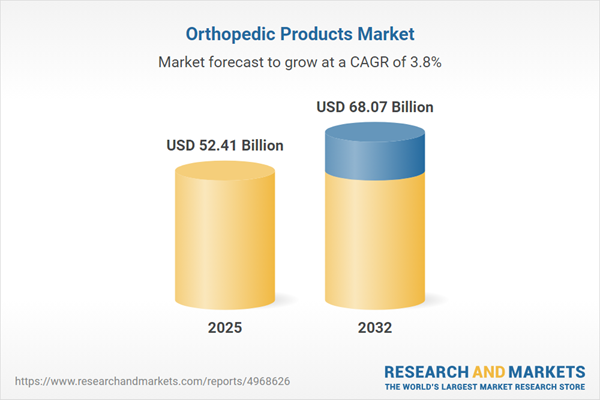Speak directly to the analyst to clarify any post sales queries you may have.
The orthopedic products market is evolving rapidly, shaped by advancements in surgical techniques, patient-centered care models, and robust global demand for innovative musculoskeletal solutions. Senior leaders must capitalize on these dynamics to secure long-term growth opportunities within an increasingly competitive landscape.
Market Snapshot: Orthopedic Products Market Overview
The orthopedic products market grew from USD 50.49 billion in 2024 to USD 52.41 billion in 2025, and is forecast to reach USD 68.07 billion by 2032, advancing at a 3.80% CAGR. This growth is fueled by rising chronic musculoskeletal conditions, aging demographics, demand for minimally invasive procedures, and sustained investments in technological innovation.
Scope & Segmentation of the Orthopedic Products Market
This comprehensive research report analyzes trends and forecasts revenues across the orthopedic sector by focusing on major segments, technological advancements, and regional diversity:
- Product Type: Joint reconstruction (hip, knee, shoulder, elbow, ankle), orthobiologics (bone graft substitutes, growth factors, stem cells), spine products (decompression, spinal fusion, stabilization), sports medicine solutions (arthroscopy devices, soft tissue repair), trauma equipment (external fixators, nails, plates).
- Application: Arthritis (osteoarthritis, rheumatoid arthritis), spine disorders (degenerative disc disease, scoliosis, spinal stenosis), sports injuries (ligament and meniscus tears), and trauma care (fractures, dislocations).
- End User: Hospitals, ambulatory surgical centers, specialty clinics.
- Distribution Channel: Direct tenders, online sales, retail sales, third-party distribution.
- Technology: Conventional surgical instruments, minimally invasive solutions, smart and robotic-assisted platforms (AI-assisted planning, implantable sensors, robot-assisted surgery systems).
- Geographic Coverage: Americas (including North America and Latin America), Europe, Middle East & Africa, Asia-Pacific. Notable countries analyzed span the United States, Canada, Brazil, United Kingdom, Germany, China, India, Japan, and more.
- Corporate Developments: Key players include Stryker Corporation, Johnson & Johnson, Zimmer Biomet Holdings, Medtronic plc, Smith & Nephew, MicroPort Scientific, ConMed Corporation, NuVasive, Globus Medical, and Orthofix Medical.
Key Takeaways for Senior Decision-Makers
- Demand for advanced implants and next-generation materials is outpacing legacy solutions, reflecting an industry-wide pivot to patient-specific products and biologics.
- Collaboration among device manufacturers, digital health providers, and payers is intensifying, with a focus on integrating data-driven platforms and value-based care models.
- Segment leadership is reinforced by the adoption of minimally invasive techniques, robotic-assisted surgeries, and digital engagement platforms across procedural workflows.
- Region-specific nuances impact innovation adoption; mature markets prioritize clinical outcomes and sustainability, while emerging economies drive uptake through cost-effective, modular solutions.
- Operational agility, supply chain transparency, and environmental stewardship are now critical differentiators, supporting brand equity and regulatory compliance in complex global markets.
Tariff Impact and Strategic Responses
Cumulative tariffs imposed in 2025 have increased input costs for orthopedic components and devices. Manufacturers are actively reevaluating their supply chains, advancing near-shoring, and securing long-term agreements with domestic suppliers to safeguard margins. Healthcare providers are adopting bundled purchasing strategies and enhanced value-based procurement processes to mitigate rising procedural costs and strengthen supplier partnerships.
Methodology and Data Sources
This report integrates primary interviews with orthopedic surgeons, hospital administrators, and industry leaders, complemented by analysis of peer-reviewed publications, regulatory filings, and financial disclosures. Robust data triangulation, statistical trend analysis, and independent expert review ensure accuracy and actionable insights.
Why This Report Matters
- Enables strategic planning by highlighting market dynamics, regional opportunities, and innovative solutions in the orthopedic sector.
- Supports informed investment decisions through comprehensive segmentation and technology adoption trends.
- Helps organizations safeguard compliance and operational performance amid tariff changes and evolving clinical standards.
Conclusion
The orthopedic products market is entering a new era of digital integration, customized care, and sustainable operations. Senior leaders leveraging these strategies will strengthen competitiveness and advance patient outcomes worldwide.
Additional Product Information:
- Purchase of this report includes 1 year online access with quarterly updates.
- This report can be updated on request. Please contact our Customer Experience team using the Ask a Question widget on our website.
Table of Contents
3. Executive Summary
4. Market Overview
7. Cumulative Impact of Artificial Intelligence 2025
Companies Mentioned
The companies profiled in this Orthopedic Products market report include:- Stryker Corporation
- Johnson & Johnson
- Zimmer Biomet Holdings, Inc.
- Medtronic plc
- Smith & Nephew plc
- MicroPort Scientific Corporation
- ConMed Corporation
- NuVasive, Inc.
- Globus Medical, Inc.
- Orthofix Medical Inc.
Table Information
| Report Attribute | Details |
|---|---|
| No. of Pages | 193 |
| Published | October 2025 |
| Forecast Period | 2025 - 2032 |
| Estimated Market Value ( USD | $ 52.41 Billion |
| Forecasted Market Value ( USD | $ 68.07 Billion |
| Compound Annual Growth Rate | 3.8% |
| Regions Covered | Global |
| No. of Companies Mentioned | 11 |









